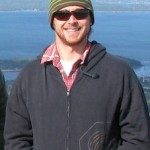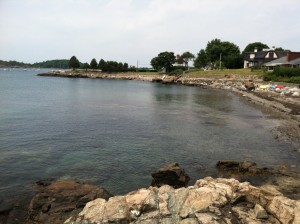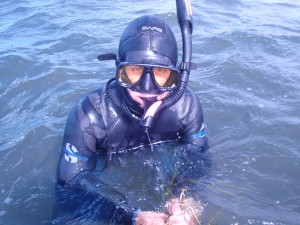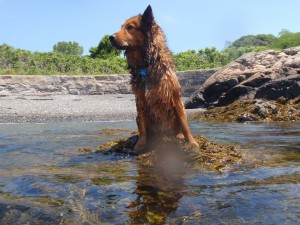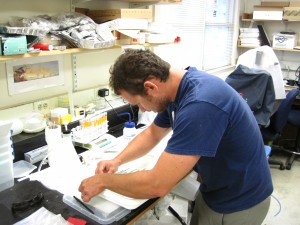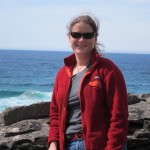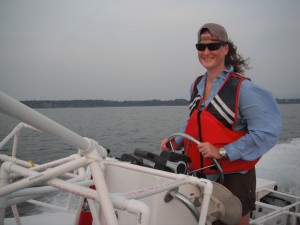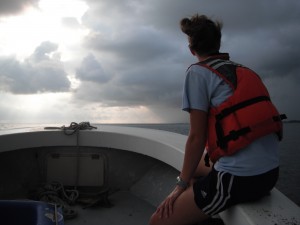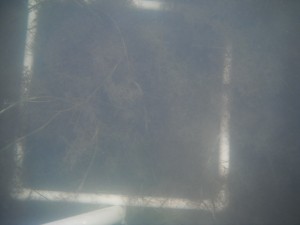An excellent day in the field
by Max Overstrom-Coleman (ZEN exchange fellow) on July 10, 2012
To be honest it is actually the 11th, but as I sit up writing this at just a shade past midnight, time seems more irrelevant than ever. I am still feeling energized from the tremendous amount of work James Douglass, my host site mentor here in Massachusetts, and I accomplished. Today we completed the sampling for the main ZEN experiment at our site. It is days like today that reinforce my love for field-work and marine science.
As I drove onto Nahant this morning the tide was halfway through its ebb and I was mentally going over the plan for what was sure to be a long day. As we envisioned it we would be in the water by about 0900 (the low was at about 1100) and our list of objectives was ambitious:
- Sample mesograzers (collect samples underwater from each experimental plot using standardized grab bags)
- Collect 10 eelgrass shoots per plot for three different analyses (1 for an analysis of epiphyte loading that would have to be done that night)
- Sample the percentage cover and canopy height of eelgrass in each plot
- Collect all of the experimental materials (bags of nutrients, plaster, and seagrass litter) to assess treatment loading and eelgrass decomposition
At this point in the season James and I are getting into a rhythm with each other. I feel like we are becoming a good team, and our ambitious plan seemed completely reasonable.
With the Northeastern Marine Lab dive truck loaded up with coolers, kayaks, dive gear and sampling equipment, we arrived at the site at a perfect tide height. The cove was empty except for a small family splashing in the shallows. It turned out that, as usual, when people show up in SCUBA gear, kids in the 8-12 age group lose their minds. I know I used to, that’s why I got certified the day I turned 13 (that was 20 years ago next week – wow I’m getting old!) and volunteered as a research diver the summer I turned 16.
It was immediately obvious that we were suddenly celebrities and it was a great opportunity to explain what we were doing and why, both to the parents and children. I think it is extremely important to communicate with the public about our research; they have to understand why it is important and see our passion. How else can we expect them to fund the science we consider so essential? In reflection, that interaction may have been one of the most important things I did today.
The sun was cooking up a hot day and it did not disappoint – I made serious strides on my raccoon tan. Before too long we were overheating and had to get in the water. I’ll spare you the nitty-gritty details, but to those of you out there who have spent that kind of time on and in the water, diving, sampling, and executing a scientific plan, I tell you honestly, it went totally smooth. By the end of it we were pretty spent and plenty hot, and it felt long but we did it without any of the usual snafus – dropped / lost / forgotten / broken gear, adverse conditions, etc… What I call an excellent day in the field.
With coolers loaded to the brim, we made it back to the lab just as we were crashing from lack of food. But after a thorough wash down to scrub off all the mud and sand that gets everywhere, and a hasty bite of food, we were back at it, preparing samples for preservation and immediately processing others. As the sunset bathed a few straggling clouds in a range of oranges and purples we were engrossed in scraping and filtering epiphytes for chlorophyll analysis, feeling pretty proud of all we accomplished. Just another day in the life of a marine ecologist.
Ducking and dodging thunderstorms in Virginia
by Kathryn Sobocinski (VIMS graduate student)
I’m a PhD student at VIMS, co-advised by Drs. Emmett Duffy and Rob Latour. While my contributions to the ZEN project thus far have been minimal as I’m in the midst of writing up my dissertation research, I did get drafted into action last week when ZEN was in need of a boat driver and an extra set of hands… I qualified. My research focuses on trophic interactions of fishes in seagrass beds—not all that different from the focus of the ZEN projects this summer. What is different is how we think about these systems. I keep reminding the folks in Emmett’s lab that their definition of “predators” is what those of us in the fish world call “prey.” Or what fishermen would call “bait.” It’s all a matter of scale.
And so I found myself in the field with ZEN, and with a few firsts after 4 years of doing field work in Chesapeake Bay. Last week we had one of those early morning tides and correspondingly early start times that made me think staying in and writing statistical code was a good idea. The first morning the alarm went off at 4:30am. My dogs definitely did not want to get up, but they saw the swimsuit and towel as a good sign—they love the beach. Little did they know that today was not their day for a sunrise swim. I made sure I had enough adequate coffee to function, and was out the door. Standing on the boat with the sun rising, I remembered why early field work is so nice: calm water, fresh air, and, most importantly, it’s not so hot! We got to the field site, Pamela got us all organized (which admittedly felt a little like herding cats since several of us were new to the scene), and we set to work installing the cages for an experiment excluding ‘predators’ from patches of Zostera to examine their effects on the seagrass community. I had toyed with conducting a predator exclusion experiment for my own work, but in the end it fell to the wayside—so it was nice to see the set-up and be involved with the execution. We completed the first stage of the set-up before the tide rolled back in and the weather caught up with us.
One of the occupational hazards of field work in southeastern Virginia in the summertime is the random thunderstorm. As grateful as I am to our friends at the National Weather Service for providing quality marine forecasts, even they occasionally get caught with their umbrellas down and we all get soaked. Tuesday was one of those days. We decided to go in the field on the forecast of “morning showers, afternoon thunderstorms,” and again, we had an early start. We motored out to the site, anchored up, had one person in the drink, and then thunder rumbled in the distance. Once, twice and we pulled anchor and ran to our thunderstorm hideout, a picturesque marina at Back Creek on the York River. We tied up just as the skies opened and the thunder boomed overhead. After four years and almost constant, sometimes daily fieldwork in this area, I had yet to duck back into the thunderstorm hideout! Thankfully, there was a nice awning to keep us mostly dry and Pamela had brought some field snacks to keep us happy as we waited for the storm to pass.
After an hour, we were back onsite and installing the second part of the experiment: putting the eelgrass into the cages and populating the cages with grazers. The wind was building and without sun, the water actually was kind of…dare I say…cold! I hopped onto the boat to have a look at the radar (the beauty of smartphone technology!) and things looked clear, so we kept pushing forward, despite the ominous looking clouds over the northeast part of the nearby Mobjack Bay. Sure enough, the next time I checked the radar, 30 minutes later, multiple storms had popped up and things were looking ugly. We called it a wrap, but this time we had no sooner left the site when the skies opened up and pelted us with big, juicy, rain drops. If you’ve never been on an open skiff in pouring rain, you have missed out on the field spa treatment of “dermabrasion”—it feels like you’re being sandblasted! Ouch. While I prefer sunglasses in such conditions to protect my eyes, Serena decided a diving mask was the ticket for protecting her face— she definitely won the field fashion contest! Thankfully, it was just rain with no thunder and lightning, so we pushed on and docked at VIMS looking like a group of drowned sea rats.
By the end of the week we had finished installing the experiment, shored up any caddywampus cages, scrubbed the outside of the cages clean (anyone who owns a boat in these parts can tell you that things in the water get fouled very quickly), and generally made sure the experiment was set. We’ll hope for fewer storms as the experiment continues. While the sun can be hot around here in the summer, it’s much nicer when the wind lays low and the thunderstorms hold off until we’re safe in the lab!

